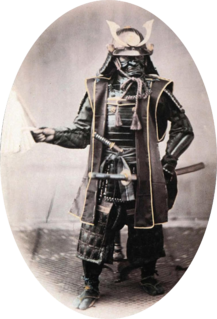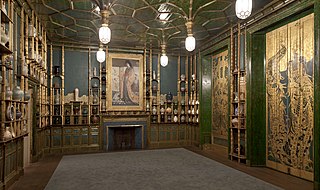 W
WJapanese aesthetics comprise a set of ancient ideals that include wabi, sabi, and yūgen. These ideals, and others, underpin much of Japanese cultural and aesthetic norms on what is considered tasteful or beautiful. Thus, while seen as a philosophy in Western societies, the concept of aesthetics in Japan is seen as an integral part of daily life. Japanese aesthetics now encompass a variety of ideals; some of these are traditional while others are modern and sometimes influenced by other cultures.
 W
WBushidō is a moral code concerning samurai attitudes, behavior and lifestyle. It is loosely analogous to the European concept of chivalry. There are multiple Bushido types which evolved significantly through history. Contemporary forms of bushido are still used in the social and economic organization of Japan. Bushido is best used as an overarching term for all the codes, practices, philosophies and principles of samurai culture.
 W
WIn Zen, ensō is a circle that is hand-drawn in one or two uninhibited brushstrokes to express a moment when the mind is free to let the body create.
 W
WFudōshin is a state of equanimity or imperturbability. It is a philosophical or mental dimension to Japanese martial arts which contributes to the effectiveness of the advanced practitioner.
 W
WHagakure, or Hagakure Kikigaki (葉隠聞書), is a practical and spiritual guide for a warrior, drawn from a collection of commentaries by the clerk Yamamoto Tsunetomo, former retainer to Nabeshima Mitsushige, the third ruler of what is now Saga Prefecture in Japan. Tashiro Tsuramoto compiled these commentaries from his conversations with Tsunetomo from 1709 to 1716; however, it was not published until many years afterwards. Written during a time when there was no officially sanctioned samurai fighting, the book grapples with the dilemma of maintaining a warrior class in the absence of war and reflects the author's nostalgia for a world that had disappeared before he was born. Hagakure was largely forgotten for two centuries after its composition, but it came to be viewed as the definitive guide of the samurai during the Pacific War. Hagakure is also known as The Book of the Samurai, Analects of Nabeshima or Hagakure Analects.
 W
WIchi-go ichi-e is a Japanese four-character idiom (yojijukugo) that describes a cultural concept of treasuring the unrepeatable nature of a moment. The term has been translated as "for this time only", and "once in a lifetime". The term reminds people to cherish any gathering that they may take part in, citing the fact that any moment in life cannot be repeated; even when the same group of people get together in the same place again, a particular gathering will never be replicated, and thus each moment is always a once-in-a-lifetime experience. The concept is most commonly associated with Japanese tea ceremonies, especially tea masters Sen no Rikyū and Ii Naosuke.
 W
WIn Japanese society, particularly in historical feudal Japan, isagiyosa is a virtue, translated with "resolute composure" or "manliness". Isagiyosa is the capability of accepting death with composure and equanimity. It stands besides other central virtues such as public-spiritedness, loyalty (seijitsusa), diligence (kinbensa) and steadiness (jimichisa).
 W
WKawaii (Japanese: かわいい or 可愛い, IPA: [kaɰaiꜜi]; 'lovely', 'loveable', 'cute', or 'adorable') is the culture of cuteness in Japan. It can refer to items, humans and non-humans that are charming, vulnerable, shy, and childlike. Examples include cute handwriting, certain genres of manga, and characters including Hello Kitty and Pikachu.
 W
WMa (間) is the term for a specific Japanese concept of negative space. In traditional Japanese arts and culture, ma refers to the artistic interpretation of an empty space, often holding as much importance as the rest of an artwork and focusing the viewer on the intention of negative space in an art piece.
 W
WMiyabi (雅) is one of the traditional Japanese aesthetic ideals, though not as prevalent as Iki or Wabi-sabi. In modern Japanese, the word is usually translated as "elegance," "refinement," or "courtliness" and sometimes to a "sweet loved one".
 W
WHarmony in Blue and Gold: The Peacock Room is the masterpiece of interior decorative art created by James McNeill Whistler and Thomas Jeckyll, translocated to the Freer Gallery of Art in Washington, DC. Whistler painted the paneled room in a rich and unified palette of brilliant blue-greens with over-glazing and metallic gold leaf. Painted between 1876–77, it now is considered one of the greatest surviving Aesthetic interiors, and best examples of the Anglo-Japanese style.
 W
WShibui (渋い) (adjective), shibumi (渋み) (noun), or shibusa (渋さ) (noun) are Japanese words which refer to a particular aesthetic of simple, subtle, and unobtrusive beauty. Like other Japanese aesthetics terms, such as iki and wabi-sabi, shibui can apply to a wide variety of subjects, not just art or fashion.
 W
WIn traditional Japanese culture, suiseki (水石) are small naturally occurring or shaped rocks which are appreciated for their aesthetic or decorative value. They are similar to Chinese scholar's rocks.
 W
WTsundoku is acquiring reading materials but letting them pile up in one's home without reading them. It is also used to refer to books ready for reading later when they are on a bookshelf.
 W
WIn traditional Japanese aesthetics, wabi-sabi (侘寂) is a world view centered on the acceptance of transience and imperfection. The aesthetic is sometimes described as one of appreciating beauty that is "imperfect, impermanent, and incomplete" in nature. It is a concept derived from the Buddhist teaching of the three marks of existence , specifically impermanence , suffering and emptiness or absence of self-nature .
 W
WYamato nadeshiko is a Japanese term meaning the "personification of an idealized Japanese woman", or "the epitome of pure, feminine beauty"; poised, decorous, kind, gentle, graceful, humble, patient, virtuous, respectful, benevolent, honest, charitable, faithful. It is a floral metaphor, combining the words Yamato, an ancient name for Japan, and nadeshiko, a delicate frilled pink carnation called Dianthus superbus, whose kanji translate into English as "caressable child".